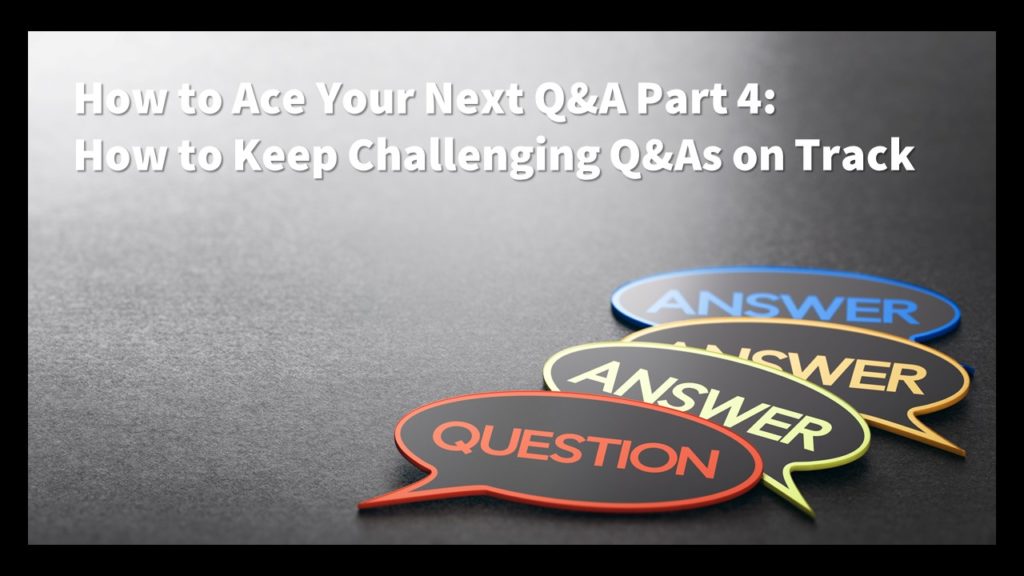How to Ace Your Next Q&A Part 4: How to Keep Challenging Q&As on Track
This post is part of a four-part series that will teach you how to prepare for and conduct effective, memorable, and meaningful question-and-answer sessions.
Persistent critiques. Lingering skepticism. Remaining doubts.
Many people perceive such challenging circumstances during the Q&A as unfriendly acts from audience members who are trying to make them look bad. Certainly, that happens. But, in many cases, these comments and questions reflect genuine objections that are centered around true concerns, rooted in misunderstanding, or based on a previous experience that has nothing to do with you.
Wouldn’t it be healthier to redefine challenging questions as opportunities to learn about these misunderstandings and disagreements so that you can offer effective responses? Wouldn’t it be worse if you didn’t get a chance to address your audience’s concerns?
Most of the tips you’ve already learned apply to tough questions, too. But managing challenging or outright hostile objections requires a few additional considerations when answers are hard to find or negativity casts a shadow over the session.

How to Tackle 3 Common Challenges
1. You Don’t Have the Answer
It’s going to happen at some point: You’ll be asked a question to which you don’t know the answer. Not knowing an answer is usually forgiven by an audience – but losing your composure is not. If you’re struggling to reply, here are six ways to remain calm:
- Pause– When you let a few seconds elapse, you may clear the momentary anxiety that is keeping you from the answer you had all along. Doing so also signals that you are taking the question seriously.
- Punt – Let the questioner know you want to think more about it and will get back to them later. (Just make sure to keep your promise.) Something like this might work: “That’s an important issue, and I’d like to think about it for a few minutes before responding.”
- Ask Them to Elaborate– If you receive a vague or confusing inquiry, ask the questioner to say a bit more before answering. When asked to elaborate, questioners typically become more specific – which makes their queries easier to answer.
- Turn to the Audience– Ask the audience to share their knowledge and collective experience. You might say, “I know we have some people in the audience who have dealt with that issue before. How have you handled it?”
- Share What You Do Know– Sometimes, knowing a specific answer isn’t as important as providing a general response. If you’re asked about exact sales figures but don’t have those numbers readily available, provide the insight you do “I don’t have the specific numbers, but I can tell you that for most of our product categories, sales have increased in the low double digits for several consecutive quarters.”
- Use These Seven Words– This technique should permanently eradicate most of your fears about being stumped. Simply say these seven words: “I don’t know, but I’ll find out.” Then, do so, whether that’s on your website, blog, social media account, or through a personal text or email.
2. You Aren’t The Right Person
Occasionally, you may be asked a question about a topic that is outside of your expertise. As your adrenaline begins to soar and you become acutely aware of the many sets of eyes awaiting your reply, you could feel compelled to answer it quickly. Resist that urge. There’s no need to risk providing incorrect information or offering speculation. If the question is outside your expertise, stay in your lane and decline to answer it.
But – and here’s the important part – explain why you can’t answer it. If you’re a professor speaking about your latest book and are asked about your university’s decision to hire a controversial new president, you might say: “You know, my main focus is on studying nineteenth-century art. I’m not privy to conversations about leadership decisions.”

3. You Need to Manage Negativity
You’ve earned your time at the mic, but the overbearing PhD in the second row is intent on showing you up. His was not a question of sheer curiosity, but rather a question embedded in a comment intended to diminish your credibility and enhance his.
Don’t get distracted by the questionable motives of a questioner. Here’s how to go from panic to poise:
- Counter Your Defensiveness– Instead of getting your hackles up, remain open. If you react with defensiveness, your audience could conclude that your defensive behavior occurred for a reason – you’re unpleasant or easily threatened or the accusation being leveled against you is true. Perhaps you can say, “That’s an interesting point. Let’s talk about it.”
- Be Curious – Consider what might be the true motivation behind a challenging question or comment. In their book Difficult Conversations: How to Discuss What Matters Most, Douglas Stone, Bruce Patton, and Sheila Heen propose some questions to ask, such as “Can you say a little more about how you see things?” and “What information might you have that I don’t” that might draw out the real concern or need. But only use this approach when the audience member seems open to a good-faith exchange – don’t offer more airtime to someone who mostly wants to hear themselves speak.
- Remember Your “Real” Audience– It should appear to the audience as if you’re responding to the questioner. But are you, really? Oftentimes, the real audience is everyone else in the room. Give your audience credit for being able to spot that boorish audience member who wants to hog the limelight. Your respectful but on-point answer will send a clear message to everyone else in the audience about your ability to handle different personalities.
- Take Back The Floor– Avoid letting the clock run too long for a long-winded, critical, and dominant audience member. You can interject if they’ve held the floor too long with a warm but firm, “In the interest of time, what specific question would you like me to address for you?”
- Depersonalize the Criticism– Deal with the issue. Don’t focus on the negative sting of the person’s comments. Rewrite the question in your head. Let’s say an audience member confronts you with “I had to call seven people to get an answer – your company is totally incompetent and is wasting my time!” Rephrase that comment in your mind as, “I would like someone to focus on my issue in a more efficient manner, please.” That kinder phrasing allows you to deal with the issue at hand without feeling the need to become defensive.
- Answer, Don’t Debate– When your first answer doesn’t satisfy and your questioner seems intent on a debate, resist the urge to go back and forth. Unless you want to promote this critic to co-presenter, offer to address the question after your talk or during the next break. (“It sounds to me that I’m going to need to learn more about your individual situation. If you’re able to stay for a few minutes after this meeting ends, I’d appreciate the chance to speak to you more about this.”). Most audiences will appreciate that you tried to answer the question, as well as freed up the floor for additional ones.
You can also signal the end of the exchange with your body language. When you’re close to the end of your answer, turn your body away from the questioner, direct your gaze toward the opposite side of the room, and ask for additional questions or comments.
- Adopt a “Yes…And” Attitude– Rather than chilling the room by taking a contradictory attitude to a well-intentioned but ill-informed question, consider employing a “Yes…And” approach. In effect, you don’t say “no.” You say this instead: “That’s a perspective many people share, and they have a point. There’s another important fact to consider, though, that too often gets ignored in that conversation.”
It is in your power to turn a negative into a positive. When you rise to the challenge, you reveal a poise and confidence that sends a message to your audience that you are capable, caring, and competent – and deserving of their trust.
Previous posts in this series:


